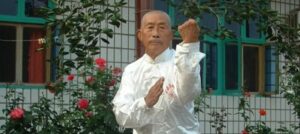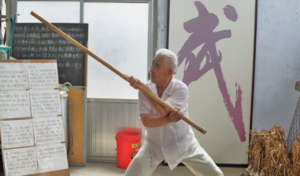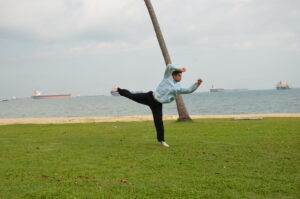The second entry in the so called other (or ancient) Taijiquan styles is about a highly influential M. Song Shuming, Song Style Taijiquan.
Mysterious Origins
Song Shuming (宋书铭, ~1840-1925) originally from Baoding, Hebei Province. It was proclaimed that he learnt the boxing method from Sun Yuanqiao (宋远桥) whom traced a lineage that goes back to the Tang Dynasty. The legend claims that the founder of the style was Xu Xuanping (許宣平) whom is said to have been a hermit that resided on Chengyang Mountain in the Tang Dynasty. Xu practiced a type of Taiji style called “Sanshiqi, 三世七” or (Tiangong Quan, 天功拳). Xu was described as tall man with long hair and a long beard. There are also stories that suggest Xu Xuanping had studied at Nanyan Gong with Daoist Master Li Daozi on Wudang Mountain. Li Daozi was thought to have practiced a method known as “Xian Tian Quan, Pre-heaven Boxing” and in another lineage of these non rudimentary Taijiquan there is the Yu Family descendants such as Yu Liandan in the Ming Dynasty also claim this line.
Meeting Xu Yusheng and the Beijing Sports Research Society
In accord with Song Shuming account. Song Yuanqiao was a martial arts master from the Qing periood and had passed a Taijiquan from ancestors back since the Tang dynasty. Song Shuming was working within Yuan Shikai’s (1859-1916) regime and became associated with Xu Yusheng (1878-1945) who was working in the Sports Department. Once Yuan Shikai passed away, Song Shuming returned to his hometown and no one knew much about him afterwards.
Xu Yusheng had studied since 6 years old withi his brother Cha Quan and Tantui since a young age and when he was 20 studied with Liu Dekuan. He also studied Taijiquan with Yang Jianhou. In 1912 along with Wu Jianquan, Zhao Xinzhou, Geng Chengxin, Guo Zhiyun, Ge Qingwu, Ji Zixiu and Heng Shoushan established the “ Beijing Sports Research Society” .
It is said that Xu Yusheng held Song Shuming in high regard because after an exchange of hands, Xu was no match for Song Shuming (at the time Song Shuming was about 72 years old whilst Xu Yusheng was 33). During the short time in Beijing (~1912-1916), Song Shuming is said to have given pointers or guidance to Xu Yusheng and his associates in the Beijing Sports Research Society. Whilst they learnt the Sanshiqi, none were taken as disciples.
An interesting story tells of Wu Tunan (~1884-1989) having in posession a text known as [Song Style Family Heritage Taiji Gong Origin and branches] and then Song Shuming pulling out an almost identical [Song Yuanqiao Taiji Gong Origin and branches]. Coincidence or just a nice story. Another story tells of an exchange with Yang Shaohou (but this also did not likely happen).
Deeper notion of Sanshiqi
In accordance with the Song manual, the San Shi Qi also represents three generations and seven (types), which refer to the theories of the style that state Mankind has 3 generations (Heaven Prior, Earth After and Man today) boxing which is divided into 7 types (Outsider, insider, Ordered, In the Hall, in the Room, Openly, Spiritually transformed).
The 37 postures are thought to have been extractions of the key methods with Yang Style Taijiquan. The practitioner does not need to follow an order of practiced, rather once mastered the postures could be combined in any order or could be made long and short through repetition as considered necessary. However, it had to flow smoothly, thus the Chang Quan (Long fist like a flowing river expression being applied).
Influence of Song Style Taijiquan to Wu Style Taijiquan.
Yang Luchan, the renowned founder of Yang Style Taijiquan taught in the Imperial Palace for the Security Guards Camp. During the time only three indviduals managed to acquire Yang Luchan’s skills. These were Wan Chuan, Ling Shan and Quan You. In order to avoid conflict to Yang’s position in King Duan’s palace, the three Manchurian students were acknowledged as disciples under Yang Banhou (Yang Luchan’s son). Quan You’s son, Ai’shen (i.e. Wu Jianquan) had studied martial arts with his father but since Quan You passed away in 1902, Wu Jianquan had placed much efforts in the research of the Taijiquan skills with fellow practitioners such as Qang Maozhai, Guo Fen, Liu Dekuan, Ji Zixiu, Xia Guixun and Heng Tai whom practiced together and developed the Taijiquan system further.
Wu Jianquan, Liu Enshou and Liu Caichen practiced Taijiquan with Quan You and later became associated with Xu Yusheng and his society. Wu Jianquan especially had sought out Song Shuming and acquired his 37 postures . Later Wu Jianquan developed from his fathers teachings, those exchanged with others and Song’s method influence what would be known as -Wu Style Taijiquan. In 1928 he moved Southwards from the capital to teach and in 1935, Wu established the Jianquan Taijiquan School in Shanghai.
Song Shuming’s Yang Style Taijiquan or something else
It is hard to determine whether the 37 postures are because of their name or their practice really just from Yang Style Taijiquan or if because many of those that acquired the 37 postures were from a Yang Style Taijiquan background that today, the 37 postures are simply almost equivalent to the methods within Yang Style Taijiquan. Another account suggested that Song had practiced with Wu Yuxiang (1812-1880) for a short while in 1951 before Wu left to travel to Zhaobao Village for advanced study and because of the short time emphasized the key postures. In fact all the postures in Song Shuming’s Sanshiqi are found in the normal Yang Style Taijiquan allbeit with slightly different practice approach and removing all repetitions.
The mystery might never unfold clearly but many of the methods in Yang Style Taijiquan and Wu Style Taijiquan today incorporate both influences from Song Shumings Sanshiqi or the theories, and the research of the respective representatives that worked together in research whilst in Beijing.
Later, historians to justify the relationship of Zhang Sanfeng to Taijiquan and Taijiquan to Wudang, further elaborated the lineages between the Tang Dynasty Hermit Xu and the elusive Song Shuming which is the basis of many other Taijiquan including Wudang Taijiquan – but more of that next time.
________________________________________
The 37 Postures of Song Shuming’s Sanshiqi
| 1. 揽雀尾 2. 单鞭 3. 提手上势 4. 白鹤亮翅 5. 搂膝拗步 6. 手挥琵琶 7. 搬拦捶 8. 如封似闭 9. 十字手 10. 抱虎归山 11. 斜单鞭 12. 肘底看捶 13. 倒撵猴 14. 斜飞势 15. 海底针 16. 扇通背 17. 撇身捶 18. 云手 19. 高探马 20. 左右分脚 21. 转身蹬脚 22. 栽捶 23. 右蹬脚 24. 左右打虎 25. 双风贯耳 26. 披身蹬脚 27. 野马分鬃 28. 玉女穿梭 29. 下势 30. 金鸡独立 31. 白蛇吐信 32. 十字摆莲 33. 指裆捶 34. 七星 35. 跨虎 36. 双摆莲 37. 弯弓射虎 | 1. Grasp the Sparrow’s Tail 2. Single Whip 3. Raise Hands Upper posture 4. White Crane Spreads Wings 5. Brush Knee Twist Step 6. Hand Strums the Pipa (Lute) 7. Deflect, Parry Punch (Banlan Chui) 8. Apparent Close up 9. Cross Hands 10. Embrace Tiger return to mountain 11. Angled Single Whip 12. Observe Fist underelbow 13. Step back and repulse the monkey 14. Slant Flying 15. Needle at bottom of the sea 16. Fan through the back 17. Hammer with fist (Pieshen Chui) 18. Cloud Hands 19. Stand high search for horse 20. Llft Right Split kick 21. Turn body press kic 22. Downwards strike 23. Right Press kick 24. Left right strike tiger 25. Twin strikes to the ear 26. Drape body press kick 27. Part the horse’s mane 28. Jade lady Thrusts 29. Lower posture 30. Golden rooster stands on one leg 31. White Snake expels poison 32. Cross outcircle kick 33. Crotch strike 34. Seven Stars 35. Ride Tiger 36. Double swinging lotus 37. Bend bow shoot the tiger |




